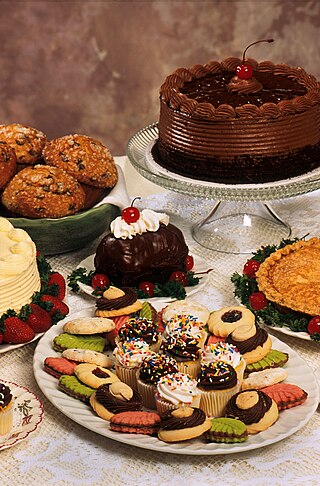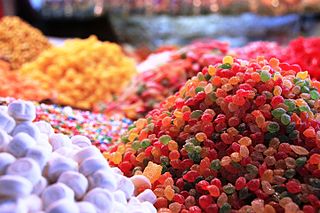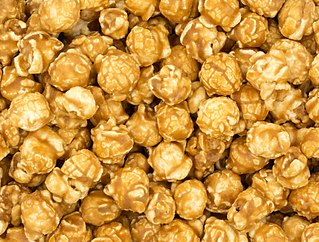
Dessert is a course that concludes a meal. The course consists of sweet foods, such as cake, biscuit, ice cream and possibly a beverage such as dessert wine and liqueur. Some cultures sweeten foods that are more commonly savory to create desserts. In some parts of the world there is no tradition of a dessert course to conclude a meal.

Confectionery is the art of making confections, or sweet foods. Confections are items that are rich in sugar and carbohydrates although exact definitions are difficult. In general, however, confections are divided into two broad and somewhat overlapping categories: bakers' confections and sugar confections.

Candy, alternatively called sweets or lollies, is a confection that features sugar as a principal ingredient. The category, also called sugar confectionery, encompasses any sweet confection, including chocolate, chewing gum, and sugar candy. Vegetables, fruit, or nuts which have been glazed and coated with sugar are said to be candied.

Caramel is an orange-brown confectionery product made by heating a range of sugars. It can be used as a flavoring in puddings and desserts, as a filling in bonbons or candy bars, or as a topping for ice cream and custard.

Candy corn is a small, pyramid-shaped candy, typically divided into three sections of different colors, with a waxy texture and a flavor based on honey, sugar, butter, and vanilla. It is a staple candy of the fall season and Halloween in North America.

Crème caramel, flan, caramel pudding, condensed milk pudding or caramel custard is a custard dessert with a layer of clear caramel sauce.

Nerds is an American candy launched in 1983 by the Sunmark Corporation under the brand name Willy Wonka Candy Company. Nerds are now made by the Ferrara Candy Company, a subsidiary of Ferrero Group. but is still distributed internationally by Nestlé. With their anthropomorphic covers, Nerds usually contain two flavors per box, each flavor having a separate compartment and opening.

Honeycomb toffee, honeycomb candy, sponge toffee, cinder toffee, seafoam, or hokey pokey is a sugary toffee with a light, rigid, sponge-like texture. Its main ingredients are typically brown sugar and baking soda, sometimes with an acid such as vinegar. The baking soda and acid react to form carbon dioxide which is trapped in the highly viscous mixture. When acid is not used, thermal decomposition of the baking soda releases carbon dioxide. The sponge-like structure is formed while the sugar is liquid, then the toffee sets hard. The candy goes by a variety of names and regional variants.

Sugar candy is any candy whose primary ingredient is sugar. The main types of sugar candies are hard candies, fondants, caramels, jellies, and nougats. In British English, this broad category of sugar candies is called sweets, and the name candy or sugar-candy is used only for hard candies that are nearly solid sugar.

Caramel apples or toffee apples are whole apples covered in a layer of caramel. They are created by dipping or rolling apples-on-a-stick in hot caramel, sometimes then rolling them in nuts or other small savories or confections, and allowing them to cool. When these additional ingredients, such as nut toppings, are added, the caramel apple can be called a taffy apple.

Cranberry sauce or cranberry jam is a sauce or relish made out of cranberries, commonly served as a condiment or a side dish with Thanksgiving dinner in North America and Christmas dinner in the United Kingdom and Canada. There are differences in flavor depending on the geography of where the sauce is made: in Europe it is generally slightly sour-tasting, while in North America it is typically more heavily sweetened.

Caramel corn or caramel popcorn is a confection made of popcorn coated with a sugar or molasses based caramel candy shell that is normally less than 1mm thick. Typically a sugar solution or syrup is made and heated until it browns and becomes thick, producing a caramelized candy syrup. This hot candy is then mixed with popped popcorn, and allowed to cool. Sometimes, a candy thermometer is used, as making caramel is time-consuming and requires skill to make well without burning the sugar. The process creates a sweet flavored, crunchy snack food or treat. Some varieties, after coating with the candy syrup, are baked in an oven to crisp the mixture. Mixes of caramel corn sometimes contain nuts, such as peanuts, pecans, almonds, or cashews.

Taffy is a type of candy invented in the United States, made by stretching and/or pulling a sticky mass of a soft candy base, made of boiled sugar, butter, vegetable oil, flavorings, and colorings, until it becomes aerated, resulting in a light, fluffy and chewy candy. When this process is complete, the taffy is rolled, cut into small pieces and wrapped in wax paper to keep it soft. It is usually pastel-colored and fruit-flavored, but other flavors are common as well, including molasses and the "classic" (unflavored) taffy.

A buñuelo (Spanish:[buˈɲwelo], alternatively called boñuelo, bimuelo, birmuelo, bermuelo, bumuelo, burmuelo, or bonuelo, is a fried dough fritter found in Spain, Latin America, and other regions with a historical connection to Spaniards, including Southwest Europe, the Balkans, Anatolia, and other parts of Asia and North Africa. Buñuelos are traditionally prepared at Christmas. It will usually have a filling or a topping. In Mexican cuisine, it is often served with a syrup made with piloncillo.

Spoon sweets are sweet preserves, served in a spoon as a gesture of hospitality in Bosnia, Serbia, Albania, Greece, Turkey, Kosovo, Cyprus, the Balkans, parts of the Middle East, and Russia. They can be made from almost any fruit, though sour and bitter fruits are especially prized. There are also spoon sweets produced without fruit.

Chocolate-covered bacon is an American food that consists of cooked bacon with a coating of either milk chocolate or dark chocolate. It can be topped with sea salt, crumbled pistachios, walnuts, or almond bits. References on the internet date back at least to 2005. The popularity of the dish has spread worldwide, and the dish has featured on television shows about food. A variant has been served at state fairs, where the bacon is served with chocolate sauce for dipping, and the dish has been developed into a gourmet food bar.


















